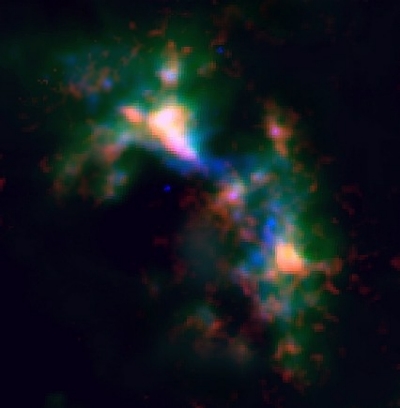The submillimetre wide field bolometer camera ArTéMiS was successfully re-commissionned in July 2014 on APEX. ArTéMiS data can now be reduced using the BoA package. Dedicated ArTéMiS data reduction scripts are now available and the required receiver parameter files. Alternative data reduction scrips in IDL will be released in the near future.
Release of the ArTéMiS Data Reduction Package

Image credit: M. Galametz, ESO
One of goals of the ArTéMiS observations is to image the cold dust reservoirs in nearby galaxies (including our own Galaxy) and thus access detail of the early phases of star formation. Among the imaged fields, 30 Doradus in the LMC was mapped at 350 μm (PI: A. Rémy-Ruyer, AIM Paris-Saclay/IAS) over a field of about 5x5 arcminutes. The composite image is a multi-wavelength combination of three different instruments and telescopes:
In blue, the IRAC 8 μm image, taken from the Spitzer Space Telescope (for the SAGE consortium), highlights the emission from polycyclic aromatic hydrocarbons;
In green, the Herschel Space Observatory PACS 100 μm image (part of the HERITAGE consortium) helps locate the warm dust;
In red, the 350 μm image, obtained by the ArTéMiS and APEX teams, probes the cold dust reservoirs where star formation occurs, or will occur.
The ArTéMiS project is led by CEA, in collaboration with AIM, IAS, IAP, CRTBT, Onsala Space Observatory, ESO and Jodrell Bank Observatory.
